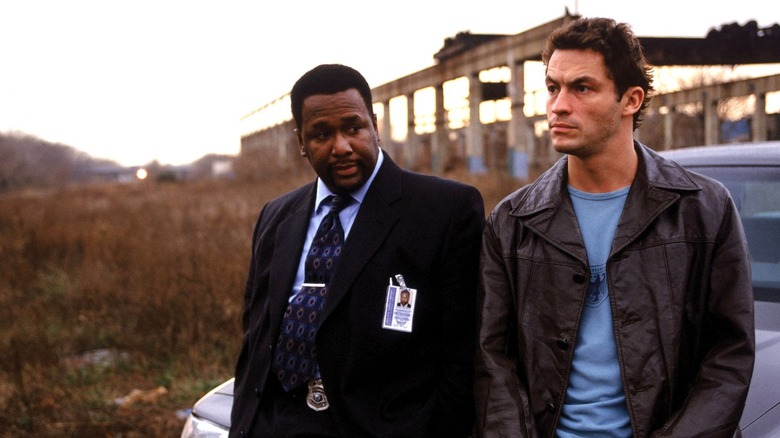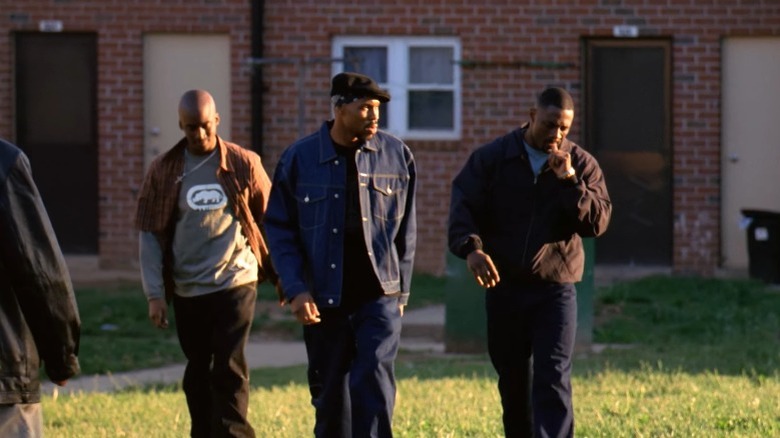The Wire Ending Explained: Way Down In The Hole

"The Wire" co-creator David Simon often compares the show to a modern Greek tragedy, going so far as to reimagine mythic Gods moved into intractable American institutions. Capitalism, drug dealing, policing, politics, education, and the media are all examined in great detail, giving you a full picture of why the characters are helpless, and fundamentally incapable of changing anything beyond, maybe, their personal situations.
The series is set in Baltimore, which occasionally gave it some difficulties due to the bleak urban picture it painted, but as co-creator Ed Burns said, "we could've taken that show into any city." Burns and Simon just had decades of life and experience in Baltimore from which to draw.
"The Wire" began with a narrow focus that gradually expanded to dig into Baltimore's nooks and crannies. The show's first season mostly focuses on the plights of both the Barksdale criminal organization and the Baltimore P.D.'s Major Crimes Unit, a ragtag, underfunded group of detectives looking to take down kingpin Avon Barksdale (Wood Harris). Their investigation grows quickly to include a cast of hundreds, down to the low-level dealer Wallace (Michael B. Jordan), whose snitching gets him killed in a scene the actor's mom had to leave the set for.
If the show was strictly about detectives and criminals, it still would have been very good. After all, crime novelists like Richard Price and George Pelecanos were on staff. But their aims were higher, and it resulted in one of the greatest television shows of the 21st century.
Humble Beginnings

"The Wire" begins with a court case, as Homicide Detective McNulty (Dominic West) sits in on a murder trial for D'Angelo Barksdale (Lawrence Gilliard, Jr.), nephew to local kingpin Avon. Also sitting in on the case is high-ranking Barksdale associate Stringer Bell (Idris Elba, who had lied a bit during his audition for the role). Stringer easily intimidates witnesses called up for the prosecution.
While many other cops we see prioritize drug and gun seizures (on top of harassing civilians), McNulty has an idea of the scope of Barksdale's control, which leads to the creation of the Major Crimes Unit, a detail focused on building cases against high-profile individuals.
The detail is made up of McNulty and a number of "humps" – old Irish cops on the verge of retirement, a Pawn Shop Unit genius named Lester Freamon (Clarke Peters), and a handful of low-ranking Narcotics cops named Herc, Kima, and Carver (Domenick Lombardozzi, Sonja Sohn, and Seth Gilliam).
The show wasn't formulaic, but every season roughly follows that blueprint, with a case being built slowly and deliberately by the Major Crimes Unit. Their targets weren't villains – they were humanized by the show, their desperation spotlighted. While McNulty's effectively the first season lead, D'Angelo is a co-protagonist, now running the courtyard where Barksdale dealers do their business. His relationships with Stringer and his uncle Avon are complicated because they're also business relationships, in a business with deadly consequences.
As Carver goes on to say in season 2, "they screw up, they get beaten. We screw up, we get a pension."
A Change In Focus

By the end of the first season, the Major Crimes Unit gets Avon in jail. They get D'Angelo and Wee-Bey (Hassan Johnson) too. McNulty, having rocked the boat too much in his pursuit of Avon, is transferred to "the docks," the marine unit, setting the stage for the show's next season. After 13 episodes following Barksdale, we move to the tragedy of Frank Sobotka (Chris Bauer) and his family, white working-class stevedores who couldn't be further from the West Baltimore courtyards.
One of the reasons "The Wire" couldn't work before the HBO era was its novelistic structure and density. At a time when every cop show on TV only let investigations run for an hour, "The Wire" focused on investigations for full seasons, zeroing in on every piece of paperwork and every bit of collateral damage. The care and time the show spent on its cases made it easy to fall in love with the characters, which in turn made it feel like a betrayal when the show moved on.
"Wire" co-creator David Simon later recalled actor Michael K. Williams (the great actor behind the Robin Hood-esque Omar Little) expressing disappointment with the second season's change of focus. In particular, Williams was upset that the show was "walking away from" its depiction of Black American struggles in the inner city, which had been such a profound part of its first season.
But the show's focus wasn't on any particular group. It was about studying a whole city.
Carcetti And The Boys Of Summer

The show's third season returned focus to the Barksdales following Avon's release from prison. That season also took to City Hall, in particular the rise of young progressive Tommy Carcetti (Aidan Gillen). Both threads become essential to the show's endgame, as the Barksdale empire finally collapses under the weight of Stringer Bell's ambition and the up-and-coming Marlo Stanfield (Jamie Hector). Carcetti, meanwhile, plots a mayoral run that will make the impossible promise of reform.
What reform? He decries "Hamsterdam," an experiment designed by disillusioned drug war veteran Maj. Bunny Colvin (Robert Wisdom). Hamsterdam involved discretely designating a number of blocks in West Baltimore where the sale of drugs is effectively rendered legal, with Colvin hoping to limit the district's homicides. It ultimately fails because of politicians like Carcetti. Meanwhile, by the season's end, Barksdale leadership is convicted by Major Crimes, and it feels almost like a series finale. Since the show struggled to get renewed, it could have been.
Luckily it wasn't, since the show's fourth season was its best, following Carcetti's mayoral run and the teenage boys living in the shadow of the Barksdale collapse. As the city government makes sweeping decisions impacting thousands, characters like Duquan Weems (Jermaine Crawford) need to take showers at their school because their water's been shut off.
The show's fourth season is a delicately assembled tragedy of institutional rot, showing the educational system's failure to support its most vulnerable subjects. Marlo gains control of the Baltimore drug trade, all but one of the kids see their lives destroyed, and Colvin, tasked with working in a middle school outreach program, sees an attempt at reform fail yet again.
McNulty's Serial Killer

The show's final season switches gears to another failed institution: the local media. What stories do we hear? What do we care about in our communities? Who decides what makes the front page? The show's answer is journalists like Scott Templeton (Tom McCarthy), who cares mostly about the Pulitzer. Most journalists buy into what the police tell them, and there's a bitter irony to the things they miss – the convenience store shooting of legendary stick-up artist Omar barely rates a paragraph.
Sensationalism thus takes precedence. McNulty and his brilliant Major Crimes co-conspirator Lester devise a scheme to bring attention and resources to the work they need to do to take down Marlo: craft a fake "serial killer" that preys on the homeless. The paper runs with it, the BPD higher-ups want more, and all McNulty and Lester have to do is keep the ruse going long enough to build their Marlo case. It's a major tonal shift for the show, less of Stanley Kubrick's "Paths of Glory" and more "Dr. Strangelove."
As with every big swing taken by characters hoping to affect change in Baltimore, Lester and McNulty fail, getting let go and an Irish wake from their former co-workers. Everything carries on as usual.
The show ended every season with a montage depicting the season's characters after the season's events, and season 5 is no different. Only this time, because it's the real finale, there's poetry to it. People have died over the course of the show, arrests have been made, but the city still runs, institutions decay, and men like Marlo and Carcetti find a way into success and hold it tight.
Read this next: The 15 Best Anthology TV Series Ranked
The post The Wire Ending Explained: Way Down In The Hole appeared first on /Film.